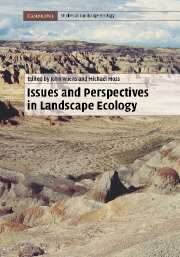Book contents
- Frontmatter
- Contents
- List of contributors
- Preface
- PART I Introductory perspectives
- PART II Theory, experiments, and models in landscape ecology
- PART III Landscape patterns
- PART IV Landscape dynamics on multiple scales
- PART V Applications of landscape ecology
- 18 Landscape ecology as the broker between information supply and management application
- 19 Farmlands for farming and nature
- 20 Landscape ecology and forest management
- 21 Landscape ecology and wildlife management
- 22 Restoration ecology and landscape ecology
- 23 Conservation planning at the landscape scale
- 24 Landscape conservation: a new paradigm for the conservation of biodiversity
- 25 The “why?” and the “so what?” of riverine landscapes
- PART VI Cultural perspectives and landscape planning
- PART VII Retrospect and prospect
- Index
- Plate section
- References
25 - The “why?” and the “so what?” of riverine landscapes
from PART V - Applications of landscape ecology
Published online by Cambridge University Press: 20 November 2009
- Frontmatter
- Contents
- List of contributors
- Preface
- PART I Introductory perspectives
- PART II Theory, experiments, and models in landscape ecology
- PART III Landscape patterns
- PART IV Landscape dynamics on multiple scales
- PART V Applications of landscape ecology
- 18 Landscape ecology as the broker between information supply and management application
- 19 Farmlands for farming and nature
- 20 Landscape ecology and forest management
- 21 Landscape ecology and wildlife management
- 22 Restoration ecology and landscape ecology
- 23 Conservation planning at the landscape scale
- 24 Landscape conservation: a new paradigm for the conservation of biodiversity
- 25 The “why?” and the “so what?” of riverine landscapes
- PART VI Cultural perspectives and landscape planning
- PART VII Retrospect and prospect
- Index
- Plate section
- References
Summary
Seeking to penetrate “the untranslatable dark,” the astronomer and poet Rebecca Elson (2001) observed that “explanation is not understanding.” This assertion was expanded by Ingrid Fiske (2001) in a review of the book: “Understanding comes through vigilant attention to the sensual world, through fidelity to the spirit and to the way our personal world interacts with the explanatory world of science.”
Accordingly, when studying riverine systems, a key question is to know what is the relevance of the “explanatory world” of landscape ecology to understand these systems. In other words, how to answer at the same time questions such as “why?” (the explanation) and “so what?” (the significance). O'Neill and Smith (2002) remind us that hierarchy theory provides a framework for that: the explanation is related to the next lower hierarchical level, and the significance to the next higher level of organization of the systems under study.
Perhaps more than others, riverine landscapes illustrate the need to address this distinction between explanation and significance. And perhaps more than in other landscapes, this distinction relates to the two realities of landscapes: they are at the same time natural and cultural. I'd like to illustrate this on the basis of two hypotheses:
The hierarchical organization of riverine landscapes can be simplified to include two main levels – natural and cultural – the second level being higher than the first.
The interacting structures and processes that characterize riverine landscapes can be explained at the lower natural hierarchical level, but they must be understood at the higher cultural hierarchical level.
- Type
- Chapter
- Information
- Issues and Perspectives in Landscape Ecology , pp. 248 - 256Publisher: Cambridge University PressPrint publication year: 2005
References
- 1
- Cited by



